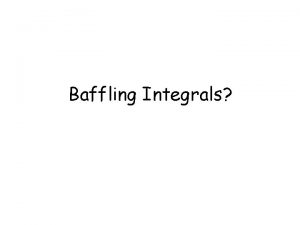4 Integrals Copyright Cengage Learning All rights reserved























- Slides: 23

4 Integrals Copyright © Cengage Learning. All rights reserved.

4. 3 The Fundamental Theorem of Calculus Copyright © Cengage Learning. All rights reserved.

The Fundamental Theorem of Calculus is appropriately named because it establishes a connection between the two branches of calculus: differential calculus and integral calculus. It gives the precise inverse relationship between the derivative and the integral. 3

The Fundamental Theorem of Calculus The first part of the Fundamental Theorem deals with functions defined by an equation of the form where f is a continuous function on [a, b] and x varies between a and b. Observe that g depends only on x, which appears as the variable upper limit in the integral. If x is a fixed number, then the integral is a definite number. If we then let x vary, the number also varies and defines a function of x denoted by g(x). 4

The Fundamental Theorem of Calculus If f happens to be a positive function, then g(x) can be interpreted as the area under the graph of f from a to x, where x can vary from a to b. (Think of g as the “area so far” function; see Figure 1. ) Figure 1 5

Example 1 If f is the function whose graph is shown in Figure 2 and find the values of g(0), g(1), g(2), g(3), g(4), and g(5). Then sketch a rough graph of g. Figure 2 6

Example 1 – Solution First we notice that . From Figure 3 we see that g(1) is the area of a triangle: = (1 2) = 1 Figure 3 To find g(2) we add to g(1) the area of a rectangle: = 1 + (1 2) = 3 Figure 3 7

Example 1 – Solution cont’d We estimate that the area under f from 2 to 3 is about 1. 3, to 3 3 + 1. 3 = 4. 3 Figure 3 For t 3, f (t) is negative and so we start subtracting areas: 4. 3 + (– 1. 3) = 3. 0 Figure 3 8

Example 1 – Solution cont’d 3 + (– 1. 3) = 1. 7 We use these values to sketch the graph of g in Figure 4. Notice that, because f (t) is positive for t 3, we keep adding area for t 3 and so g is increasing up to x = 3, where it attains a maximum value. For x 3, g decreases because f (t) is negative. Figure 3 Figure 4 9

The Fundamental Theorem of Calculus If we take, f (t) = t and a = 0, then we have Notice that g (x) = x, that is, g = f. In other words, if g is defined as the integral of f by Equation 1, then g turns out to be an antiderivative of f, at least in this case. And if we sketch the derivative of the function g shown in Figure 4 by estimating slopes of tangents, we get a graph like that of f in Figure 2. So we suspect that g = f in Example 1 too. Figure 2 10

The Fundamental Theorem of Calculus To see why this might be generally true we consider any continuous function f with f (x) 0. Then can be interpreted as the area under the graph of f from a to x, as in Figure 1. In order to compute g (x) from the definition of a derivative we first observe that, for h 0, g(x + h) – g(x) is obtained by subtracting areas, so it is the area under the graph of f from x to x + h (the blue area in Figure 5). Figure 1 Figure 5 11

The Fundamental Theorem of Calculus For small h you can see from the figure that this area is approximately equal to the area of the rectangle with height f (x) and width h: g(x + h) – g(x) hf (x) so Intuitively, we therefore expect that 12

The Fundamental Theorem of Calculus The fact that this is true, even when f is not necessarily positive, is the first part of the Fundamental Theorem of Calculus. Using Leibniz notation for derivatives, we can write this theorem as when f is continuous. 13

The Fundamental Theorem of Calculus Roughly speaking, this equation says that if we first integrate f and then differentiate the result, we get back to the original function f. 14

Example 2 Find the derivative of the function Solution: Since is continuous, Part 1 of the Fundamental Theorem of Calculus gives 15

Example 3 Although a formula of the form may seem like a strange way of defining a function, books on physics, chemistry, and statistics are full of such functions. For instance, the Fresnel function is named after the French physicist Augustin Fresnel (1788– 1827), who is famous for his works in optics. This function first appeared in Fresnel’s theory of the diffraction of light waves, but more recently it has been applied to the design of highways. 16

Example 3 cont’d Part 1 of the Fundamental Theorem tells us how to differentiate the Fresnel function: This means that we can apply all the methods of differential calculus to analyze S. Figure 7 shows the graphs of f (x) = sin( x 2/2) and the Fresnel function Figure 7 17

Example 3 cont’d A computer was used to graph S by computing the value of this integral for many values of x. It does indeed look as if S(x) is the area under the graph of f from 0 to x [until x 1. 4 when S(x) becomes a difference of areas]. Figure 8 shows a larger part of the graph of S. Figure 8 18

Example 3 cont’d If we now start with the graph of S in Figure 7 and think about what its derivative should look like, it seems reasonable that S (x) = f (x). [For instance, S is increasing when f (x) 0 and decreasing when f (x) 0. ] So this gives a visual confirmation of Part 1 of the Fundamental Theorem of Calculus. Figure 7 19

The Fundamental Theorem of Calculus The second part of the Fundamental Theorem of Calculus, which follows easily from the first part, provides us with a much simpler method for the evaluation of integrals. 20

Differentiation and Integration as Inverse Processes 21

Differentiation and Integration as Inverse Processes We end this section by bringing together the two parts of the Fundamental Theorem. We noted that Part 1 can be rewritten as which says that if f is integrated and then the result is differentiated, we arrive back at the original function f. 22

Differentiation and Integration as Inverse Processes Since F (x) = f (x), Part 2 can be rewritten as This version says that if we take a function F, first differentiate it, and then integrate the result, we arrive back at the original function F, but in the form F(b) – F(a). Taken together, the two parts of the Fundamental Theorem of Calculus say that differentiation and integration are inverse processes. Each undoes what the other does. 23
 Copyright 2015 all rights reserved
Copyright 2015 all rights reserved Copyright © 2015 all rights reserved
Copyright © 2015 all rights reserved Dell all rights reserved copyright 2009
Dell all rights reserved copyright 2009 Copyright © 2018 all rights reserved
Copyright © 2018 all rights reserved Copyright cengage learning. powered by cognero
Copyright cengage learning. powered by cognero All rights reserved example
All rights reserved example All rights reserved sentence
All rights reserved sentence Creative commons vs all rights reserved
Creative commons vs all rights reserved Confidential all rights reserved
Confidential all rights reserved Sentinel value
Sentinel value 2012 pearson education inc
2012 pearson education inc Microsoft corporation. all rights reserved.
Microsoft corporation. all rights reserved. Microsoft corporation. all rights reserved
Microsoft corporation. all rights reserved Microsoft corporation. all rights reserved
Microsoft corporation. all rights reserved Pearson education inc. all rights reserved
Pearson education inc. all rights reserved Warning all rights reserved
Warning all rights reserved All rights reserved c
All rights reserved c All rights reserved formula
All rights reserved formula Warning all rights reserved
Warning all rights reserved Confidential all rights reserved
Confidential all rights reserved Microsoft corporation. all rights reserved
Microsoft corporation. all rights reserved 2010 pearson education inc
2010 pearson education inc 2017 all rights reserved
2017 all rights reserved Copyright 2010 pearson education inc
Copyright 2010 pearson education inc













































